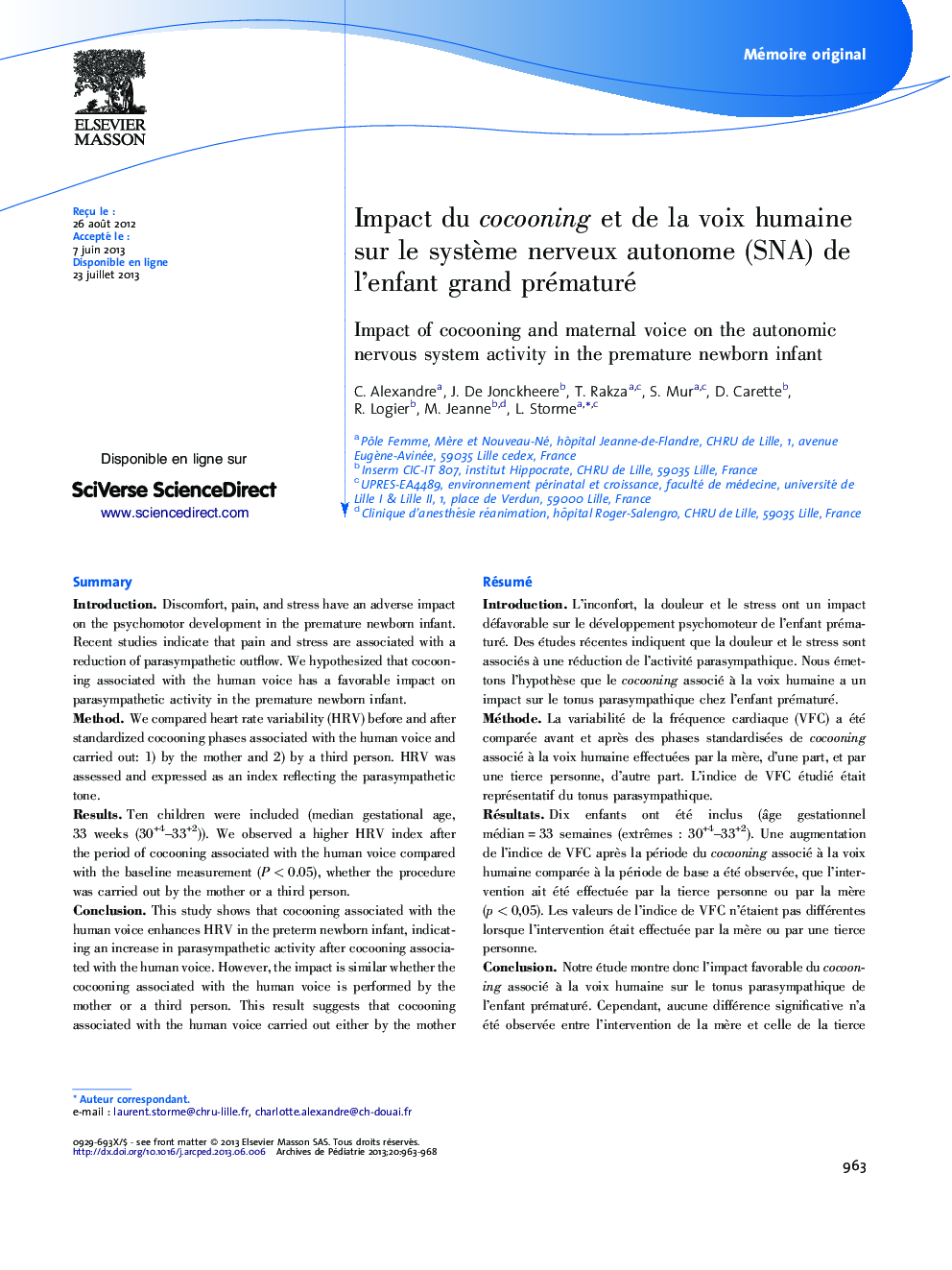| کد مقاله | کد نشریه | سال انتشار | مقاله انگلیسی | نسخه تمام متن |
|---|---|---|---|---|
| 4146723 | 1272650 | 2013 | 6 صفحه PDF | دانلود رایگان |

RésuméIntroductionL’inconfort, la douleur et le stress ont un impact défavorable sur le développement psychomoteur de l’enfant prématuré. Des études récentes indiquent que la douleur et le stress sont associés à une réduction de l’activité parasympathique. Nous émettons l’hypothèse que le cocooning associé à la voix humaine a un impact sur le tonus parasympathique chez l’enfant prématuré.MéthodeLa variabilité de la fréquence cardiaque (VFC) a été comparée avant et après des phases standardisées de cocooning associé à la voix humaine effectuées par la mère, d’une part, et par une tierce personne, d’autre part. L’indice de VFC étudié était représentatif du tonus parasympathique.RésultatsDix enfants ont été inclus (âge gestationnel médian = 33 semaines (extrêmes : 30+4–33+2). Une augmentation de l’indice de VFC après la période du cocooning associé à la voix humaine comparée à la période de base a été observée, que l’intervention ait été effectuée par la tierce personne ou par la mère (p < 0,05). Les valeurs de l’indice de VFC n’étaient pas différentes lorsque l’intervention était effectuée par la mère ou par une tierce personne.ConclusionNotre étude montre donc l’impact favorable du cocooning associé à la voix humaine sur le tonus parasympathique de l’enfant prématuré. Cependant, aucune différence significative n’a été observée entre l’intervention de la mère et celle de la tierce personne. Ce résultat suggère que le cocooning associé à la voix humaine, qu’il soit réalisé par la mère ou par une tierce personne, a un effet favorable sur le confort de l’enfant prématuré.
SummaryIntroductionDiscomfort, pain, and stress have an adverse impact on the psychomotor development in the premature newborn infant. Recent studies indicate that pain and stress are associated with a reduction of parasympathetic outflow. We hypothesized that cocooning associated with the human voice has a favorable impact on parasympathetic activity in the premature newborn infant.MethodWe compared heart rate variability (HRV) before and after standardized cocooning phases associated with the human voice and carried out: 1) by the mother and 2) by a third person. HRV was assessed and expressed as an index reflecting the parasympathetic tone.ResultsTen children were included (median gestational age, 33 weeks (30+4–33+2)). We observed a higher HRV index after the period of cocooning associated with the human voice compared with the baseline measurement (P < 0.05), whether the procedure was carried out by the mother or a third person.ConclusionThis study shows that cocooning associated with the human voice enhances HRV in the preterm newborn infant, indicating an increase in parasympathetic activity after cocooning associated with the human voice. However, the impact is similar whether the cocooning associated with the human voice is performed by the mother or a third person. This result suggests that cocooning associated with the human voice carried out either by the mother or a third person contributes to decreasing stress and discomfort in the premature newborn infant.
Journal: Archives de Pédiatrie - Volume 20, Issue 9, September 2013, Pages 963–968